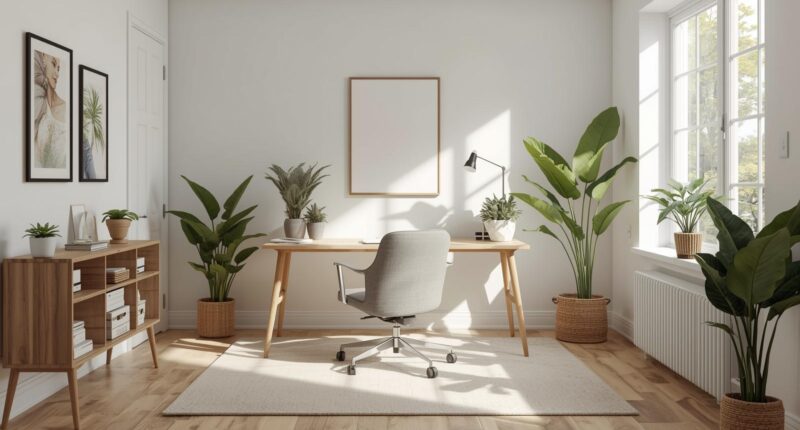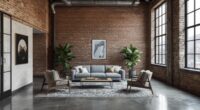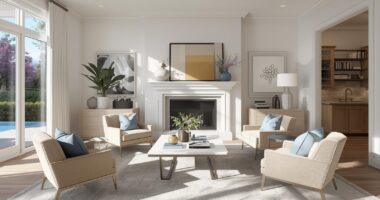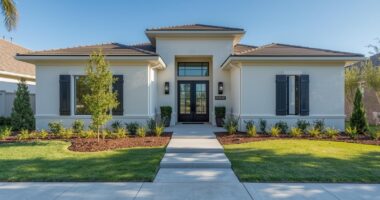How to Design a Lifestyle-Focused Home Office
Introduction: The New Era of Work and Lifestyle
As remote work continues to rise, the home office has evolved from a temporary setup to a vital part of modern living. However, creating a workspace that only focuses on productivity isn’t enough — it should also reflect your lifestyle, comfort, and personality.
A lifestyle-focused home office is designed to support both your professional goals and personal well-being. It combines functionality, aesthetics, and mindfulness, helping you stay productive while maintaining balance in your everyday life.
Let’s explore how to design a home office that perfectly aligns with your work style and lifestyle.
What Is a Lifestyle-Focused Home Office?
A lifestyle-focused home office is more than just a desk and a chair. It’s an environment that enhances focus, creativity, and health — while fitting seamlessly into your overall lifestyle.
This concept focuses on creating a workspace that feels personal, inspiring, and supportive of your long-term well-being.
Key Features Include:
-
Comfortable and ergonomic design
-
Aesthetic harmony with the rest of your home
-
Healthy lighting and air quality
-
Smart organization and minimal clutter
-
A touch of personalization that motivates you
Your home office should be a place where productivity and lifestyle meet in harmony.
Table – Traditional vs. Lifestyle-Focused Home Offices
| Aspect | Traditional Home Office | Lifestyle-Focused Home Office |
|---|---|---|
| Design Goal | Functional workspace | Blends work and personal lifestyle |
| Furniture | Basic desk and chair | Ergonomic and aesthetic furniture |
| Atmosphere | Neutral and plain | Personalized, inspiring, and relaxing |
| Technology | Standard setup | Smart, eco-friendly, and efficient |
| Wellness Integration | Often ignored | Prioritizes posture, lighting, and mindfulness |
This comparison shows that the modern home office is no longer just about work — it’s about creating an environment that supports your whole lifestyle.
Step 1 – Choose the Right Location
The foundation of a great home office design begins with choosing the right spot.
Find a space that is quiet, well-lit, and offers minimal distractions.
Tips for Choosing a Space
-
Pick a room with natural light — it boosts mood and focus.
-
Avoid high-traffic areas like the living room.
-
Ensure good ventilation and comfortable temperature.
-
If space is limited, transform a corner or nook into a functional workspace.
Choosing a location that suits your routine sets the tone for both comfort and productivity.
Step 2 – Prioritize Comfort and Ergonomics
Your physical comfort directly affects your productivity and long-term health.
An ergonomic setup ensures that you work efficiently without physical strain.
Ergonomic Essentials
-
Adjustable chair that supports your spine.
-
Desk height that allows elbows to rest at 90 degrees.
-
Monitor position at eye level to prevent neck pain.
-
Keyboard and mouse placement that reduces wrist strain.
Link: Want to elevate your living environment? Check out our article — Outdoor Living Spaces That Transform Your Home Experience — to see how design can enhance comfort and lifestyle.
Step 3 – Incorporate Natural Light and Greenery
Lighting has a major influence on focus and energy levels. Natural light helps regulate your circadian rhythm, improving concentration and reducing fatigue.
Lighting Tips for a Lifestyle-Focused Office
-
Position your desk near a window for maximum daylight.
-
Use LED task lamps for evenings.
-
Add plants like snake plants or pothos to improve air quality and aesthetics.
-
Choose warm lighting for relaxation zones and cooler tones for focused work.
Bringing nature indoors promotes mental clarity and creativity throughout the workday.
Step 4 – Create a Personalized Aesthetic
Your workspace should reflect your personality and taste. A visually pleasing office increases motivation and emotional connection to your work.
Ways to Personalize Your Space
-
Choose a color palette that inspires calm and focus (e.g., white, beige, sage, or navy).
-
Add artwork or motivational quotes.
-
Use texture and décor — wood, metal, or soft fabrics for comfort.
-
Keep your space tidy with minimalist organization.
Your environment should make you feel inspired every time you sit down to work.
Step 5 – Integrate Technology for Efficiency
A lifestyle-focused office should balance technology with simplicity.
Avoid cluttered cables and outdated gadgets — use smart tech tools that make work easier.
Smart Tech to Include
-
Wireless keyboard and mouse for a clean look.
-
Cable organizers and hidden outlets.
-
Smart plugs to control lighting and devices.
-
Noise-canceling headphones for focus.
-
High-speed Wi-Fi and backup drives for reliability.
Technology should enhance — not overwhelm — your workspace.
Step6– Design for Work-Life Balance
A lifestyle-oriented office supports both work and relaxation.
It should allow you to stay productive while reminding you to take breaks and recharge.
Work-Life Balance Design Tips
-
Use a small couch or reading chair for short breaks.
-
Add music or aroma diffusers for relaxation.
-
Separate your work area from your personal space after hours.
-
Use storage solutions to keep clutter out of sight.
When your environment respects your boundaries, you achieve both productivity and peace of mind.
Step 7 – Maintain a Healthy Work Environment
Your home office should promote physical and mental wellness. Small adjustments can make a big difference in long-term health and happiness.
Wellness Practices to Adopt
-
Stand up and stretch every 45–60 minutes.
-
Keep a water bottle at your desk to stay hydrated.
-
Add an air purifier for clean indoor air.
-
Declutter regularly for mental clarity.
Link: For wellness-based design inspiration, visit Well + Good Home Design Section — a trusted platform for health-focused interior living ideas.
Step 8 – Blend Function with Flexibility
Your home office should evolve with your needs.
Create a flexible space that can adapt to different types of work, creativity, or relaxation.
Ideas for Flexible Design
-
Use modular furniture that can be rearranged easily.
-
Include foldable tables or movable partitions.
-
Add a standing desk converter for posture variety.
-
Use dual-purpose décor that works for both work and leisure.
A dynamic workspace keeps your motivation high and prevents burnout.
Conclusion: Designing a Home Office That Reflects Your Lifestyle
Your workspace is more than a place to work — it’s a reflection of who you are and how you live.
A lifestyle-focused home office empowers you to be productive, creative, and comfortable — all while maintaining balance and well-being.
By blending aesthetics, functionality, and personal touch, you can create a space that inspires focus and relaxation.
Invest in your environment, and you’ll notice how it transforms your work performance and overall happiness.









